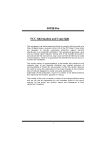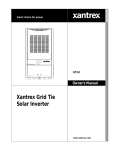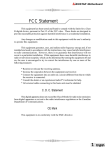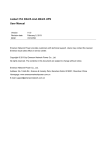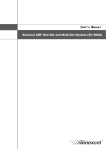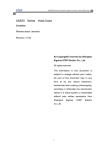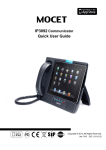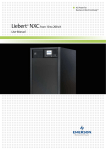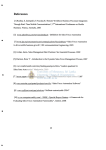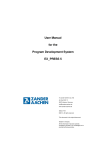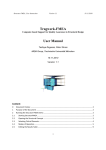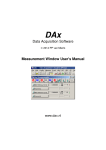Download User`s Manual - Cyber Power Systems
Transcript
User’s Manual STP3T10KE STP3T15KE STP3T20KE STP3T30KE CyberPower Systems Inc. www.cpsww.com Safety Precautions This manual is about the installation and the operation of UPS (Here after referred as UPS). Please read this manual carefully before move 、installation、operation and maintenance. The UPS must be debugged and maintained by professional engineers of manufacturer or qualified agents. Otherwise, human safety and UPS would be in danger; We do not take the responsibility if the damage of UPS or human being was caused by users. UPS is only for commercial / industrial use and not for life long equipment. APPLICABLE STANDARDS This product complies with CE 73/23 & 93/68 (low voltage safety) and 89/336 (EMC) , and EMC standards of Australia and New Zealand (C-Tick) , and the following UPS product standards: *IEC62040-1-1-General and safety requirements for use in operator access area *IEC/EN62040-2 EMC requirements CLASS C3 *IEC62040-3 Performance requirements and test methods Continued compliance requires installation in accordance with these instructions and the use of manufacturer approved accessories only. WARNING- High earth leakage current The earth is critical. Before connect the input supply (include both commonercial power supply and battery supply) . This equipment must be earthed in accordance to local electrical authority codes of practice. Earth leakage current exceeds 3.5 mA and is less than 1000 mA. Transient and steady-state earth leakage currents, which may occur when starting the equipment, should be taken into account when selecting instantaneous RCCB or RCD devices. Residual Current Circuit Breakers ( RCCBs) must be selected insensitive to DC unidirectional pulses ( class A ) and transient current pulses ( RCCBs) . Note it that the earth leakage currents of the load will also flow across RCCB or RCD. Components can be maintained by users All the equipment maintenance and servicing procedures involving internal access need special tools and should be carried out only by trained personnel. The components that can only be accessed by opening the protective cover with tools cannot be maintained by user. This UPS full complies with “IEC62040-1-1-General and safety requirements for use in operator access area UPS”.Dangerous voltages are present within the battery box. However, the risk of contact with these high voltages is minimized for non-service personnel. Since the component with dangerous voltage can only be touched by opening the protective cover with a tool, the possibility of touching high voltage component is minimized. No risk exists to any personnel when operating the equipment in the normal manner, following the recommended operating procedures in this manual. Battery Voltage Higher Than 400Vdc The battery maintenance and service procedures need internal access with special tools and keys which should be carried out only by trained persons Smart Tower UPS 10-30KVA User Manual I Safety Precautions SPECIAL CARES SHOULD BE TAKEN WHEN WORKING WITH BATTERIES OR ASSOCIATED EQUIPMENT. WHEN CONNECTED TOGETHER, THE BATTERY TERMINAL VOLTAGE WOULD EXCEED 400Vdc ,AND IT IS POTENTIALLY LETHAL. Battery manufacturers supply details of all necessary precautions of battery banks usage and in the vicinity of the battery banks that should be taken all the time.Togther concern of the the local environmental recommendations and the provision of protective clothing, first aid facilities, fire-fighting facilities and firefighting rules Battery life will be shorter as the enviroment temperature rise up. Periodical batteries changes make UPS work normally. Ensure enough standby time When replacing the batteries,using the same type and modal ,and the same quantity. When batteies connected,the battery terminal voltage will exceed 400Vdc dangerous voltage, to avoid electric shock accident, when replacing the batteries, please observe the following warning: 1 Wear eye shield, to prevent accidental arc injury eyes; 2 Don't wear a watch,a ring or any similar metal objects; 3 Use insulated tools; 4 Wear protective overalls and rubber gloves; 5 Do not put metal tools or similar metal parts on any battery; 6 Before remove battery connection terminals, disconnected the load on the battery; 7Do not exposed battery on fire,to invoid the explosion danger to humanbeing safety; 8 Do not Short the battery ,it will cause electric shock or fire; 9 If skin touch electrolyte, rinse with water immediately. Recycle UPS components containing heavy metals, must be treat as industrial waste after be scrapped II Smart Tower UPS 10-30KVA User Manual Contents CONTENTS Chapter 1 Quick Start ................................................................................................................................ 1 1.1 Introduction .................................................................................................................................... 1 1.2 Unpacking &Inspection .................................................................................................................. 1 1.3 Environment Inspection ................................................................................................................. 1 1.4 Installation Inspection .................................................................................................................... 1 Chapter 2 Installation Guidance ................................................................................................................ 2 2.1 Introduction .................................................................................................................................... 2 2.2 Position Selection .......................................................................................................................... 2 2.2.2 Battery Room .............................................................................................................................. 3 2.2.3 Storage ....................................................................................................................................... 3 2.3 Disassembly, Initial Checking and Positioning ............................................................................... 3 2.3.1 System Disassembly .................................................................................................................. 3 2.3.2 UPS Composition ....................................................................................................................... 4 2.3.3 Operation Space ......................................................................................................................... 4 2.3.4 Front Operation and Rear Operation .......................................................................................... 4 2.3.5 Final Position .............................................................................................................................. 4 2.3.6 Cable Entry ................................................................................................................................. 5 2.4 Protection Device........................................................................................................................... 5 2.4.1 Rectifier and Bypass Input .......................................................................................................... 5 2.4.2 Battery ........................................................................................................................................ 5 2.4.3 UPS Output................................................................................................................................. 6 2.5 Power Cables ................................................................................................................................ 6 2.5.1 Maximum stable state current and system cable configuration................................................... 6 2.5.2 Cable Connection ....................................................................................................................... 6 2.5.3 Connection of Battery (Only Applicable to Build-in Battery UPS model) ..................................... 7 2.6 Control and Communication Cable ................................................................................................ 8 2.6.1 Battery and Environmental Temperature Detection Dry Contacts (Optional) .............................. 9 2.6.2 Remote EPO Input Port (Optional) ............................................................................................. 9 2.6.3 Generator Input Dry Contact (Optional) .................................................................................... 10 2.6.4 BCB Interface (Optional) ........................................................................................................... 11 2.6.5 Battery voltage alarm Output Dry Contact Interface (Optional) ................................................. 11 2.6.6 Integrated alarm output dry contact Interface (Optional) ........................................................... 12 2.6.7 Mains/Commercial power failure alarm Output Dry Contact Interface (Optional)...................... 12 2.6.8 RS232 Port and SNMP Card Port............................................................................................. 13 2.7 Installation Diagram .................................................................................................................. 13 Chapter 3 Operation ................................................................................................................................ 15 3.1 Introduction .................................................................................................................................. 15 3.1.1 Work Principle........................................................................................................................... 15 3.1.2 Bypass Module principle ........................................................................................................... 15 3.1.3 Battery Temperature Compensation ......................................................................................... 16 3.2 Operation Mode ........................................................................................................................... 16 3.2.1 Normal Mode ............................................................................................................................ 16 3.2.2 Battery Mode ............................................................................................................................ 17 3.2.3 Auto-Start Mode ........................................................................................................................ 17 3.2.4 Bypass Mode ............................................................................................................................ 17 3.2.5 Maintenance Mode ................................................................................................................... 17 3.2.6 ECO Mode ................................................................................................................................ 17 3.2.7 Frequency Converters Mode .................................................................................................... 17 3.2.8 Parallel connection redundancy mode ...................................................................................... 17 3.3 Battery Management ................................................................................................................... 18 Smart Tower UPS 10-30KVA User Manual III Contents 3.3.1 General function ....................................................................................................................... 18 3.3.2 Advanced Functions (Battery Self-test Maintenance) ............................................................... 18 3.4 Battery Protection ........................................................................................................................ 18 Chapter 4 Installation of Parallel Operation System ................................................................................ 19 Chapter 5 Operating Procedures............................................................................................................. 20 5.1 Power Switches ........................................................................................................................... 20 5.2 UPS Start-up................................................................................................................................ 20 5.2.1 Normal Start Mode .................................................................................................................... 20 5.2.2 Battery Module Start Only Applicable for the UPS with Battery Cold Start Elements ....... 22 ( ) 5.3 Procedures of Switch between Operation Modes ........................................................................ 22 5.3.1 Procedure of Switch the UPS into Battery from Normal Mode .................................................. 22 5.3.2 Procedure of Switch the UPS into Bypass from Normal Mode ................................................. 22 5.3.3 Procedure of Switch the UPS into Normal from Bypass Mode ................................................. 22 5.3.4 Procedure of Switch the UPS into a Maintenance Bypass from Normal Mode ......................... 23 5.3.5 Procedure of Switch the UPS to Normal from a Maintenance Bypass Mode ............................ 23 5.4 Procedure of Completely Power the UPS down .......................................................................... 23 5.5 EPO Procedure............................................................................................................................ 23 5.6 Language Selection ..................................................................................................................... 24 5.7 Password Control ........................................................................................................................ 24 Chapter 6 Operator Control and Display Panel ....................................................................................... 25 6.1 Introduction .................................................................................................................................. 25 6.1.1 LED Indicator ............................................................................................................................ 26 6.1.2 Audible Alarm (buzzer) ............................................................................................................. 26 6.1.3 Functional Keys ........................................................................................................................ 26 6.2 LCD Display Type ........................................................................................................................ 27 6.2.1 Default Screen .......................................................................................................................... 27 6.2.2 Data Screen .............................................................................................................................. 27 6.2.3 Setting Display screen .............................................................................................................. 28 6.2.4 Function screen ........................................................................................................................ 28 6.2.5 State Screen ............................................................................................................................. 28 6.2.6 Confirm screen ......................................................................................................................... 29 6.2.7 History Record Display ............................................................................................................. 29 6.3 Detailed Description of Menu Items ............................................................................................. 29 6.4 Alarm List ..................................................................................................................................... 30 Chapter 7 Maintenance ........................................................................................................................... 32 7.1 Instruction of Maintenance Operation .......................................................................................... 32 7.1.1 Precautions ............................................................................................................................... 32 7.1.2 Instruction to Bypass Module .................................................................................................... 32 Chapter 8 Product Specification .............................................................................................................. 33 8.1 Applicable Standards ................................................................................................................... 33 8.2 Environmental Characteristics ..................................................................................................... 33 8.3 Mechanical Characteristics .......................................................................................................... 33 8.4 Electrical Characteristics (Input Rectifier) .................................................................................... 34 8.5 Electrical Characteristics (Intermediate DC Link)......................................................................... 34 8.6 Electrical Characteristics (Inverter Output) .................................................................................. 34 8.7 Electrical Characteristics(Bypass Mains Input) ............................................................................ 35 8.8 Efficiency ..................................................................................................................................... 36 IV Smart Tower UPS 10-30KVA User Manual Chapter 1 Quick Start Chapter 1 Quick Start 1.1 Introduction This chapter describes the basic principles of UPS installation and commission; it helps users to achieve a rapid installation and commissioning 1.2 Unpacking &Inspection Check the following items after receiving the products. 1. Check that the package is intact. If there is any damage or humidification, please contact the local agents or offices. 2. Check the outer type designation label in consistence with the booked product. If not, please contact the local agents or offices. 3. Check if there is no water inside the package and any damage or crack to the shell. If not, please contact the local agents or offices. 4. Check that the nameplate is the same as the outer type designation label. If not, please contact the local agents or offices. 5. Check whether the internal accessories are complete. If not, please contact the local agents or offices. 1.3 Environment Inspection Confirm the items as following before UPS installation. ℃ 1. Check the environment temperature, if above 25 ,please add cool system. 2. If the operation environment temperature is below 0 3. If the UPS operation environment humidity is above 90% or condensation, please add additional protection. 4. Whether there is sunshine or external species invasion in the UPS operation environment, please add additional protection. 5. If there is dust, inflammable and explosive gas in UPS operation environment, please add additional protection. ℃, battery life reduces half every each 10℃ up. ℃ or not, add heat equipment if yes.. Note: Environment temperature above 20 1.4 Installation Inspection After installation, check the items as below: 1. If the UPS is installed on inflame retarding material? 2. All the cables connected correctly 3. All the grounded system connected correctly. 4. If the operation space around UPS enough. 5. Confirm all the UPS external terminals are tight, and the torque should meet the requirements. 6. Confirm that there are no screws, cables and other electric conductor left inside the UPS. If there is, please take out. Smart Tower UPS 10-30KVA User Manual 1 Chapter 2 Installation Guidance Chapter 2 Installation Guidance 2.1 Introduction This chapter introduces UPS installation, as particularity of every installation condition. This chapter just provides guidance of the general installation procedures and methods. Please installation engineers operate according to difference for each place, Warning-Installation can only be done by authorized engineers 1. Do not apply electrical power to the UPS equipment before the approval of commissioning engineer. 2. The UPS should be installed by a qualified engineer in accordance with the information contained in this chapter. Note: 3-Phase 4-Wire Input Power is required The standard UPS can be connected to TN, TT and IT AC distribution system (IEC60364-3) of 3-phase 5-wire WARNING: battery hazards SPECIAL CARE SHOULD BE TAKEN WHEN WORKING WITH THE BATTERIES ASSOCIATED WITH THIS EQUIPMENT. When connecting the battery, the battery terminal voltage will exceed 400Vdc and is potentially lethal. Eye protection should be worn to prevent injury from accidental electrical arcs. Remove rings, watches and all metal objects. Only use tools with insulated handles. Wear rubber gloves. If a battery leaks electrolyte, or is otherwise physically damaged, it must be replaced, stored in a container resistant to sulfuric acid and disposed of in accordance with local regulations. If electrolyte comes into contact with the skin, the affected area should be washed immediately with water. 2.2 Position Selection 2.2.1 Power Distribution Room The UPS is designed for indoor installation, and it should be located in a clean environment with adequate ventilation to keep the environmental temperature within the required specification parameter. The UPS internal fans provide forced draft cooling, cold air flow through the front grille into the internal of UPS, and exhaust hot air from the back grille. Do not block ventilation hole. If necessary, install some indoor exhaust fans to avoid temperature increase. In dusty environment, it is better to install air filter, optional component of UPS Note: The UPS should be installed only on concrete surface or other surface that is solid and not combustible. 2 Smart Tower UPS 10-30KVA User Manual Chapter 2 Installation Guidance 2.2.2 Battery Room The batteries will generate a small amount of hydrogen and oxygen at the end of charging, so keep the batteries installation environment adequate fresh air ventilation must meet EN50272-2001 requirements. The ambient temperature of the batteries should be stable. Environment temperature is the main factor influent batteries capacity and life. The batteries standard operation temperature is 20°C. Above this temperature, it will reduce the battery life, and below this temperature it will reduce the battery capacity. If the average operation temperature of battery is increased from 20ºC to 30ºC, then the life of the battery will be reduced by 50%. If the operating temperature of the battery is above 40ºC, then the battery life will be decreased in exponent rate. In normal situation, the battery allowing temperature should be at 15°C to 25°C. Keep batteries far away from heat and air vents. UPS use external batteries, and the battery protection device (a DC circuit breaker) must be mounted close to batteries as possible. Between it with batteries, use the shortest power cables connection distance. 2.2.3 Storage If there is no need to install the UPS immediately, must be kept the UPS inside a room so as to protect it against too wet or too hot environment. The battery needs to be stored in a dry and cool place with good ventilation. The most appropriate storage temperature is 20 ºC ~ 25ºC. 2.3 Disassembly, Initial Checking and Positioning When the product is delivered to the user after the first inspection, packaging, determine the intact; and then open the package, check the equipment integrity; if damaged, please immediately notify the carrier. 2.3.1 System Disassembly Open the wooden case first, and then take out the foam pay attention not to scratch the UPS Fig 2-1 UPS Packing Diagram Tip: After disassembly, as shown in Figure 2-1, remove the bolts that connect to the UPS cabinet and wooden Cashion, then lift the UPS cabinet to the installation position. The dismantlement should be careful so as not to scratch the UPS. Smart Tower UPS 10-30KVA User Manual 3 Chapter 2 Installation Guidance After the carton opening, verify the product label and confirm the correctness of the equipment. The equipment label is attached on the back and front door which show the UPS model, capacity and main parameters. Warm Tips: Please dispose the wasted material in accordance to environmental protection requirements after disassembly. To prolong the service life, the UPS location shall be selected to ensure: convenient wiring Sufficient space for operation good ventilation , enough for UPS heat dissipation No ambient corrosive gases Not damp and no heat sources Not dusty Meet the fire protection requirements The operating environment temperature is 20 -25 ,the batteries maximum efficiency temperature range (for the information about the battery storage and transportation as well as the environment, please refer to table 7-2) ℃ ℃ 2.3.2 UPS Composition UPS compositions refer to fig 2-2. a. 10KVA~30KVA cabinet without built-in battery b.10KVA~30KVAcabinet with built-in battery Fig 2-2 UPS Component Diagram 2.3.3 Operation Space As UPS has no ventilation grills at either side, no clearance is required for the sides. For the convenience of daily operation tightening the power supply terminals in the UPS cabinet, with the exception meet the local requirements, enough space also should be retained for the cabinet front and back doors. When the front doors are fully opened, a person can pass through freely. Keep the UPS cabinet back door distance away from the wall or other cabinet for maintenance more than 800mm. 2.3.4 Front Operation and Rear Operation The UPS device layout makes the maintenance, diagnosis and repair of the cabinet completely at the front and rear, thus reducing the side space requirements 2.3.5 Final Position After UPS has been finally located, ensure the expansion bolts fixing the UPS reliably. 4 Smart Tower UPS 10-30KVA User Manual Chapter 2 Installation Guidance 2.3.6 Cable Entry 10KVA~30KVA UPS adopts underneath power cable routing. 2.4 Protection Device For safety, it is recommended to install external circuit breakers or other protective devices in the AC supply system of the UPS system. This section provides general guidance to the trained and qualified professionals. Training and qualified professionals should be aware of the equipment to be installed local wiring regulations and relative knowledge 2.4.1 Rectifier and Bypass Input Install appropriate over current protective devices in the distribution unit of the commercial power supply, the installation should be considered the power cable current capacity and the system overload capacity. It is recommended for general that use specified in table 2-2 current 125% IEC60947-2 tripping curve C (normal) thermal magnetic circuit breaker. Note For IT power system,4-pole protective device must be installed in power input distribution cabinet external of UPS If install UPS higher input power distribution leakage detecting instrument, the adopted residual current action protector (RCD) must: Sensitive to DC unidirectional pulses (class A) in the power network Insensitive to transient current pulses Normal sensitivity, adjustable in 0.3A ~ 1A The Residual Current Circuit Breaker (RCCB) must be sensitive to DC unidirectional pulses (class A) in the network, insensitive to transient current pulses, as shown in fig 2-3 respectively. Fig 2-3 RCCB sign 2.4.2 Battery A battery bank contains 40 series batteries, Intermediate (the joint of the 20th and 21st batteries), elicits a midline, plus the first, the last totally 3 cables connect to UPS terminals. Battery elicited cables must go through a DC circuit breaker then connect to the relevant UPS terminal rows showing in fig 2-4 as below: Forty series batteries connection Fig 2-4 Diagram of series batteries connection Smart Tower UPS 10-30KVA User Manual 5 Chapter 2 Installation Guidance 2.4.3 UPS Output There UPS main output switch was built in; users should install overcurrent protector for each output branch in the additional distribution cabinet. 2.5 Power Cables Design the cables according to the descriptions of this section and local regulation of wiring standards, and consider the environmental conditions. Refer to IEC60950-1 table 3B. Warning Prior to the cables connection, confirm be aware of the UPS input and the commercial power switch positions and states. Ensure switches are opened, and attach a WARNING label to prevent others to operate the switch. 2.5.1 Maximum stable state current and system cable configuration Table 2-1 Maximum stable state current and configuration of cable system System Name Capacity System capacity Cabinet dimension mm W*D*H Main Input Output Battery PE STP3T10KE STP3T15KE STP3T20KE STP3T30KE 10KVA 15KVA 20KVA 30KVA 540*690*1100 (with built-in battery) 280*730*668 (without built-in battery) 320* 781* 788 Rated current A 15 22.5 30 45 Cable mm2 4 6 10 10 Rated current A 15 22.5 30 45 Cable mm2 4 6 10 10 Rated current A 18 26.5 36 53 Cable mm2 6 10 10 16 Cable mm2 10 10 16 25 Terminal location shows as Figure 2-13 Warning FAILURE TO FOLLOW ADEQUATE EARTHING CAN RESULT IN ELECTROMAGNETIC INTERFERENCE ( EMI), ELECTRIC SHOCK HAZARD AND FIRE HAZARD 2.5.2 Cable Connection Important The operations described in this section must be performed by trained and qualified professionals. If you have any doubt, please contact with manufacturer local Customer Service & Support department. After the equipment finally positioned, please refer to the installation diagram following the procedures as following: 1. Ensure all the input distribution switched off, and disconnect all the UPS internal power, Attach warning labels on these switches to prevent others to operate. 2. Open the UPS cabinet front door, and remove the cover plate, then the input and output terminals, battery terminals and earth terminal are visible. 6 Smart Tower UPS 10-30KVA User Manual Chapter 2 Installation Guidance 3. Connect the input earth wire to input earth terminal. Note: the earth wire connection should comply with the local and national regulations 4. When the input of UPS rectifier and bypass adopt a same power supply, AC input cables should be connected to the UPS input terminal (Main input A-B-C-N), the output load cables should be connected to the UPS output terminal (Output A-B-C-N). When there are two ways electric supply inputs, connect the power cable for UPS rectifier and bypass respectively, main input terminal of UPS (Main input A-B-C-N) and the input terminal of the bypass, and at the same time remove the short circuit copper bars of the main and the bypass; For the cable tight, the required force moment including 30kg (M5), 50kg (M6), 180kg (M8) and 260kg (M10). Attention ensures the power cable phase sequence consistent and there is no circuit short at any joint of cable terminals. 5. Connect the battery cables between the UPS battery terminals and the battery switch. ENSURE battery cable CORRECT polarity connection. Warning-Hazardous battery terminal voltage exceed of 400Vdc Ensure the connection from battery terminals to battery Circuit breack and to UPS terminals polarity consistance: Positive terminal to positive terminal, negative terminal to negative terminal, and disconnect one or more than one cables every battery layer.Do not connect the cables and the battery circuit breakers without approval from the trained and qualifiied commissioning engineer. 6. Re-install all the protective cover plates 2.5.3 Connection of Battery (Only Applicable to Build-in Battery UPS model) The below 30KVA UPS contain battery build-in model, in which there is an internal battery breaker. At the same time, the UPS also offers external battery connection terminals. When choosing external battery, it should be added an extra battery breaker between the UPS and the external battery bank Users can choose below 30KVA UPS with or without build in batteries (40*12AH), Customer can install the battery and connect the battery cables according to the actual situation. We also provide the battery cables as an option for customers to choose. The method of build-in batteries connection shown as following fig. 2-5: Smart Tower UPS 10-30KVA User Manual 7 Chapter 2 Installation Guidance Fig 2-5a Build-in battery connection diagram The UPS and batteries are connected by Anderson terminals as shown below, according to the mark of cables, connect cables W404,W405,W406 to K(+),K(N),K(-). Fig 2-5b Build-in battery connection diagram 2.6 Control and Communication Cable As shown in fig. 2-6, there are dry contact interfaces (J2-J10), communication interfaces (RS232 interface, 485 interface, and SNMP card interface) and LBS interface. 8 Smart Tower UPS 10-30KVA User Manual Chapter 2 Installation Guidance Fig 2-6 Dry contact interface and communication interface There is optional dry contact board, the UPS receives external signal from zero-voltage (dry contacts) contact signal to bypass module phoenix terminals. Via software program operation, it the signal will be valid when these contacts shorted with +24V pins. All the control cables must be dual isolated, and they should be separated to the power cables, within maximum wiring distance 20m~50m,the control cable 2 section area should be 0.5 to 1.5 mm . 2.6.1 Battery and Environmental Temperature Detection Dry Contacts (Optional) Input dry contact J2 and J3 can detect the battery and environment temperatures, which can be used for environment monitoring and battery temperature compensation. J2 and J3 interfaces diagram is shown in fig 2-7, interface description refer to table 2-2. J2 J3 Fig 2-7 Temperature dry contacts J2 and J3 Table 2-2 Description of input dry contact J2 and J3 Position Name Description J2.1 J2.2 J3.1 J3.2 TEMP_BAT GND TEMP_ENV GND Battery temperature detection Power ground Environment temperature detection Power ground Note: Temperature detection requires specified temperature sensor(R25=5KOhm, B25/50=3275), please confirm with manufacturer, or contact manufacturer local office when ordering. 2.6.2 Remote EPO Input Port (Optional) The UPS has an Emergency Power OFF (EPO) function which can be activated by pressing the EPO button on the UPS control panel or through a remote-contact provided by user. The EPO button is protected by a hinged plastic cover. J4 is the input port of remote EPO, it does work when NC and +24v are shorted, When the EPO requires to be triggered, disconnected NC and +24v, or shorted NO and +24v. The port diagram is shown in Fig 2-8, the port description is shown in table 2-3. Smart Tower UPS 10-30KVA User Manual 9 Chapter 2 Installation Guidance +24V J4 Fig 2-8 remote EPO input port Diagram Table 2-3 Description of remote EPO input port Position Name Description J4.1 EPO_NC EPO is activated when disconnecting fromJ4.2 J4.2 +24V +24V, connect the common terminal of NC and NO J4.3 EPO_NO EPO is activated when shorting with J4.2 The EPO is triggered by shorting pin 2 and 3 or opening pin 2 and 1 of J4. If the external emergency stop function is required, J10 is reserved for. The external emergency stop needs extra shielded cable connect the NO or NC remote switch to the J10 port; if the function is not in use disconnect the pin 2 and pin 3,and short the pin1and pin2 of J4 Note 1. The UPS emergency stop action will shut down rectifier, inverter and static bypass. However, it does not internally disconnect the input main power. For the UPS full power down, Disconnect the upper input switch when trigger the EPO. 2. Pin 1 and 2 of J4 have been shorted before leaving factory 2.6.3 Generator Input Dry Contact (Optional) J5 is the generator input status interface. Connecting pin 2 of J5 with + 24V power supply, indicates the generator is connected to the system. The interface diagram is shown in fig 2-9 and interface description is shown in table 2-4 Generator Fig 2-9 Generator access interfaces and connections Diagram 10 Smart Tower UPS 10-30KVA User Manual Chapter 2 Installation Guidance Table 2-4 Maintenance bypass switch and output switch status interface Description Position Name J5.1 J5.2 J5.3 +24V GEN GND Description +24V power supply Connection status of generator Power ground 2.6.4 BCB Interface (Optional) BCB_ONL BCB_CON T BCB_DRV J6 and J7 are battery circuit breaker (BCB) interface. The interface diagram is shown in fig 2-10 and the interface description is shown in table 2-5. Fig 2-10 BCB Interface Table 2-5 Description of BCB Interface Location J6.1 Name BCB_DRV J6.2 BCB_CONT J7.1 GND J7.2 BCB_ONL Description BCB drive signal: providing +24V, 20mA drive signal , BCB contact status connect to BCB’s normal open signal Power ground ( BCB online input normal open ),it shows BCB is online when this signal connects to GND. 2.6.5 Battery voltage alarm Output Dry Contact Interface (Optional) GND BAT_LOW_NO BAT_LOW_NC J8 is an output dry contact interface that outputs battery alarms. When the voltage is lower than set value, it will provide an auxiliary dry contact signal via the isolation of a relay. The interface diagram is shown in fig 2-11, and description is shown in table 2-6. Fig 2-11 Integrated Battery alarm dry contact interface diagram Table 2-6 Integrated Battery alarm dry contact interface description Smart Tower UPS 10-30KVA User Manual 11 Chapter 2 Installation Guidance Location Name J8.1 J8.2 J8.3 BAT_LOW_NC BAT_LOW_NO GND Description Battery warning relay (normally closed) will be open during warning Battery warning relay (normally open) will be closed during warning Center of battery warning relay 2.6.6 Integrated alarm output dry contact Interface (Optional) J9 is a integrated alarm output dry contact interface, when one or more alarms is/are triggered, the system will send a integrated alarm information, it provides an auxiliary dry contact signal via the isolation of a relay. The interface diagram is shown in fig 2-12, and description is shown in table 2-7 GND ALARM_NO ALARM_NC J9 Fig 2-12 Integrated alarm dry contact interface diagram Table 2-7: Integrated alarm dry contact interface description Location J9.1 J9.2 J9.3 Name Description ALARM_NC Integrated warning relay (normally closed) will be open during warning ALARM_NO Integrated warning relay (normally open) will be closed during warning GND Centre of integrated warning relay 2.6.7 Mains/Commercial power failure alarm Output Dry Contact Interface (Optional) J10 is a output dry contact interface for mains power failure alarm, when the mains fails, the system will send a mains failure alarm, to provide an auxiliary dry contact signal via an isolation relay. The interface diagram is shown in fig 2-13, and the description is shown in table 2-8. Fig 2-13 Mains failure warning dry contact interface diagram Table 2-8 Mains failure warning dry contact interface description Location J10.1 12 Name Description UTI_FAIL_NC Mains failure warning relay(normally closed) will be open during warning Smart Tower UPS 10-30KVA User Manual Chapter 2 Installation Guidance Location J10.2 J10.3 Name Description UTI_FAIL_NO Mains failure warning relay( normally open) will be closed during warning GND Centre of mains failure warning relay 2.6.8 RS232 Port and SNMP Card Port RS232 and RS485 Ports: provide serial data for authorized maintenance or commissioning engineers, and also can be used for integrated network monitoring system. SNMP Card Port: be used for field installation the communication option card (SNMP card). 2.7 Installation Diagram Smart Tower UPS 10-30KVA User Manual 13 Chapter 2 Installation Guidance a. 10KVA~30KVA wiring diagram (with built-in battery) b. 10KVA~30KVA wiring diagram (without built-in battery) Fig 2-13 10~30KVA UPS wiring diagram 14 Smart Tower UPS 10-30KVA User Manual Chapter 3 Operation Chapter 3 Operation This chapter introduces basic knowledge of UPS operation, including working principle, operation mode, battery management and protection. Warning: Hazardous mains voltage and/or battery voltage present(s) behind the protective cover 1 .The components that can only be accessed by opening the protective cover with tools cannot be operated by user. 2 Only qualified trained professinals are authorized to remove such protective covers. . 3.1 Introduction UPS provides high quality uninterruptible AC power to your critical load. The UPS output power voltage and requency do not be affected by mains input low voltage, power off, peaks and so on. The UPS adopts the latest high-frequency double-conversion pulse width modulation (PWM) technology and fully digital control (DSP) technology, high reliability, convenient for use.. 3.1.1 Work Principle As shown in fig 3-1, the AC input from mains transformer to DC Power in rectifier. The inverter transformer this DC power which is coming form battery set(s) or the rectifier transformed power as AC power ,and supply load through the distribution modules. When the commercial power is off, the battery set(s) supply back-up power for the load through the inverter; it also can utility the mains through the static bypass to load. When the UPS needs maintenance or repairing, transfer the load to maintenance bypass, the power supply would be uninterrupted. Fig 3-1 System principle framework diagram 3.1.2 Bypass Module principle Fig 3-1 shows the “bypass module” contains electronic controlled switch circuits that allow the load connected to the inverter output or through the static bypass line to bypass power supply. IN normal condition, inverter supply power for load; if overload or inverter failure, the load will be switched to static bypass power supply. Smart Tower UPS 10-30KVA User Manual 15 Chapter 3 Operation Under normal operation condition, the inverter output and static bypass power supply must be fully synchronized to achieve uninterrupted load switch between inverter output and static bypass line, The synchronization of the inverter output and static bypass power is achieved by the inverter control circuit, When the static bypass power frequency is in a allowed value for synchronization, the inverter control circuit always keep the inverter output frequency tracking the static bypass power frequency. UPS support a manually controlled maintenance bypass. When UPS shut-down for maintenance or repair. It enables the critical load to be powered from this bypass power supply Note When the UPS is running in bypass mode or supporting power for load on maintenance bypass, there is no abnormal ac power protection for load equipment. 3.1.3 Battery Temperature Compensation Connect the temperature sensor to UPS battery temperature interface in battery cabinet to achieve optimized battery management. Fig 3-2 Temperature compensation diagram 3.2 Operation Mode The UPS are on-line, double-conversion, reverse-transfer UPS, and they have the following operation modes: Normal mode Battery mode Auto-Restart mode Bypass mode Maintenance mode (manual bypass) ECO mode Frequency converters mode Parallel operation redundancy mode 3.2.1 Normal Mode Mains supplying power to UPS rectifiers provide DC to inverters, which provide continuously uninterrupted AC power to the load. The rectifier provides battery floating charge or boost charge via charger simultaneously. 16 Smart Tower UPS 10-30KVA User Manual Chapter 3 Operation 3.2.2 Battery Mode Batteries provide back-up power to load through inverter mode is battery mode. The UPS automatically switch to battery mode, and load power is not interrupted. After the mains returns, the UPS automatically switches back to normal mode without any manual intervention, while the load power uninterrupted. Note: UPS can also be started through battery (charged) mode via battery cold start function when the mains failure. Therefore, the battery power can be used independently to improve the utilization rate of UPS. 3.2.3 Auto-Start Mode The UPS has auto boot function, and that is after a long time mains failure, the inverter shut down when the battery reaches the End of Discharge voltage (EOD). The UPS may be programmed to “Auto Recovery after EOD” after a delay time if the AC main returns. This mode and any delay time are programmed by the qualified professionals During the automatically delay boot process, the UPS will charge the batteries to prevent another mains failure risks for load equipment in future. 3.2.4 Bypass Mode In normal mode, if there is inverter failure, inverter overload or manually turn off the inverter, static switch will switch to bypass power supply the load power will not be interrupted 3.2.5 Maintenance Mode For UPS maintenance or repair, switch load through the manual switch the critical load power supply will no be off. Be aware that switch the UPS system to bypass power supply mode first, then remove the anti-manipulation cover, rotate the handle to maintenance, then disconnect all the mains, bypass and internal battery switches and the external battery cabinet switches. Warning: Hazard wrong operation in maintenance bypass mode After UPS transfered to operate in maintenance bypass mode, power modules and bypass modules do not work ,there is no display on LCD, the input,output terminalsand the N bus are energized with electricity. 3.2.6 ECO Mode When choosing economical (ECO) mode, in most situations, the UPS double-conversion would be forbidden for energy saving. In ECO mode, the load power supply priority provided by the bypass. When the frequency and voltage of bypass power within normal range, load power provided by bypass; beyond this range, the system will switch to output of inverter, but such would cause load power interruptions, the interruption time is less than 3/4 cycle. For example, the frequency is 50Hz, the interruption time is less than 15ms; frequency is 60Hz, the interrupt time of less than 12.5ms. 3.2.7 Frequency Converters Mode UPS can be set as frequency converter mode, and it provides stable frequency output as 50Hz or 60Hz, the input frequency range is 40Hz ~ 70Hz. In this mode, the static bypass is unavailable, and the battery can be selected according to the actual requirements of battery mode. 3.2.8 Parallel connection redundancy mode To increase the system capacity or reliability, or both increase the system capacity and reliability, we could paralleled some number of UPS units directly, and each UPS will automatic load-sharing by its internal parallel logic control. The capacity of a parallel operation system can be up to 6 units. Smart Tower UPS 10-30KVA User Manual 17 Chapter 3 Operation 3.3 Battery Management 3.3.1 General function The following functions should be performed by trained and qualified professionals with specified software. 1. Constant current boost charging The charge current can be set. 2. Constant voltage boost charging Set the charge voltage according to battery type. For Valve Regulated Lead Acid (VRLA) batteries, the maximum boost charge voltage should not exceed 2.4V/cell 3. Float charge The float charge Voltage can be set as required by the type of battery. For Valve Regulated Lead Acid (VRLA), float charge voltage should be between 2.2V and 2.3V. 4. Float charge temperature compensation (optional) The temperature compensation coefficients can be set depending on battery type. 5. End of discharge (EOD) protection When the battery voltage falls below the EOD, the battery converter will automatically be off, disconnect the battery to avoid excessive battery discharge. EOD is adjustable from 1.6V to 1.75V per cell (VRLA) or 0.9 to 1.1 V per nickel-cadmium (Ni-Cd) cell. 6. Battery low voltage alarm time Setting range, prior to the battery discharge termination 3 to 60 minutes, the default is 5 minutes. 3.3.2 Advanced Functions (Battery Self-test Maintenance) Battery periodic discharge, and each time discharge 30% capacity. The actual load must exceed 30% of the UPS nominal capacity. If the load is below 30%, it does not perform automatic discharge maintenance. The periodic interval can be set from every 30 to 360 days. The battery self-test can be disabled. Conditions—batteries have been float charged for at least 5 hours, remain more than 30% of their rated capacity, the load within 20~100% of UPS rated capacity Be triggered—manually operate the command “Battery Maintenance Test” on LCD panel 3.4 Battery Protection The following functions should be performed by trained and qualified professionals with specified software. 1. Battery Low voltage alarm The battery under-voltage pre-warning occurs before the end of discharge. After this pre-warning, the battery should have the capacity for 3 remaining minutes discharging with full load. The time is user configured from 3 to 60 minutes. 2. End of discharge (EOD) protection Before the battery voltage falls below the EOD, the battery converter will automatically be off, disconnect the battery to avoid excessive battery discharge. EOD is adjustable from 1.6V to 1.75V per cell (VRLA) or 0.9 to 1.1 V per nickel-cadmium (Ni-Cd) cell. 3. Battery Circuit Breaker (BCB) Alarm (Optional) The BCB disconnecting occur this alarm. The batteries connect to UPS through the external battery circuit breaker (BCB). BCB is closed manually, the switch trips when there is battery over-temperature or electricity leakage by the UPS control circuit controlling. 18 Smart Tower UPS 10-30KVA User Manual Chapter 4 Installation of Parallel Operation System Chapter 4 Installation of Parallel Operation System The parallel operation system installation is of same procedures of the installation the single system requirement and this chapter. The single devices should be located parallel and be connected as shown in fig. 4-1, the difference is that the lengths of the output cables of the single devices is not more than 10m. It is recommended to use an external bypass cabinet to facilitate maintenance and system testing. Other power supplies Mains power input, L1, L2, L3, N terminals Mains power input, L1, L2, L3, N terminals Rectifier Charger Inverter Rectifier Charger Inverter Output power supply Load connected Fig. 4-1 Typical 1+N parallel operation system Note: when the load exceeds the capacity of a single device, the maintenance bypass switch CB3 must be removed. The parallel operation need double insulation shielded cable up to 30m long, the control cables for the parallel operation must be connected all the single devices to form a closed loop, as shown in fig.4-2. Fig.4-2 parallel cables Smart Tower UPS 10-30KVA User Manual 19 Chapter 5 Operating Procedures Chapter 5 Operating Procedures This chapter describes UPS operation instructions in detail. All functional buttons and LED display involve in operation instructions. Please refer to chapter 5. During operation, the buzzer alarm may occur at any time. Select “mute” on LCD to muffle the audible alarm. Warning-Hazardous mains voltage and/or battery voltage present(s) behind the protective cover 1. The components that can only be accessed by opening the protective cover with tools. It cannot be operated by users. 2. Only qualified service professionals are authorized to remove such covers. 5.1 Power Switches As shown in fig 5-1, open the front door of UPS, the power switch is visible, it includes: input switch, output switch and maintenance bypass switch (with anti-misoperation stop plate) a. 10KVA~30KVA (without built-in batteries) Fig. 5-1 b. 10KVA~30KVA (with built-in batteries) Main switch location diagram 5.2 UPS Start-up The UPS system only has a maintenance bypass isolated switch, and all the other transfers are processed automatically by internal control logics. 5.2.1 Normal Start Mode This procedure must be followed when turn on the UPS from a fully power down system condition. The operating procedures are as follows: Warning This procedure results in mains voltage being applied to the UPS output terminals. If any load equipment is connected to the UPS output terminals please check with the user load that it is safe to be supplied power. If the load is not ready to receive power then ensure that the output switch of external distribution cabinet is off. 20 Smart Tower UPS 10-30KVA User Manual Chapter 5 Operating Procedurce Warning Please confirm that UPS output rotating switch point to UPS, with anti-misoperation stop plate for rotating switch is fixed well. 1. Close UPS bypass input switch and input switch in turns The LCD starts up at this time. The Rectifier indicator flashes during the rectifier startup. The rectifier enters normal operation state, and after about 30s, the rectifier indicator goes steady green. After initialization, the bypass static switch closes. The UPS Analogue LEDs indicate as shown in table 5-1: Table 5-1 Indicator status LED Status Rectifier indicator Battery indicator Bypass indicator Inverter indicator Load indicator Status indicator Green Red Green Off Green Green Warning The bypass input circuit breaker must be switched on first, then the input circuit breaker, otherwise, the rectifier could not be started and the power would be out of the system’s control. During the inverter starts up time, the inverter indicator flashes. After the rectifier enters normal operation state, UPS power supply will transfer from bypass to inverter, then the bypass indicator turns off, and load indicator lights on. The status of indicators is shown in table 5-2 Table 5-2 Indicators Status LED Status Rectifier indicator Green Battery indicator Red Bypass indicator Off Inverter indicator Green Load indicator Green Status indicator Green If UPS belongs to build-in battery type, please close the internal battery DC switch. Battery indicator will be off a few minutes later, the battery will be charged by UPS which is running in normal operation mode. The indicator status is shown in table 5-3. If your UPS is without build-in battery type, please close the external battery DC switch. Warning Please confirm battery connection correct before closing external battery switch. Table 5-3 Indicator status LED Status Rectifier indicator Battery indicator Bypass indicator Inverter indicator Load indicator Load indicator Green Green Off Green Green Green Smart Tower UPS 10-30KVA User Manual 21 Chapter 5 Operating Procedures 5.2.2 Battery Module Start ) (Only Applicable for the UPS with Battery Cold Start Elements 1. Check if the batteries have been connected, and close the internal/external battery switch. 2. Press the red start-up button of battery on the back door panel. 3. The LCD starts up at this time, press battery cold start again for about 5 seconds. The green battery indicator flashes. The rectifier enters normal operation states and after about 30s, the battery indicator goes steady green. 4. The inverter starts up automatically, the green inverter indicator flashes. The inverter will output after 60s. Then UPS runs in battery mode. a. 10KVA~30KVA (without built-in battery) b. 10KVA~30KVA (with built-in battery) Fig. 5-2 Diagram of battery starting button location 5.3 Procedures of Switch between Operation Modes 5.3.1 Procedure of Switch the UPS into Battery from Normal Mode Switch off Mains input, UPS enters battery mode. If need to switch UPS to normal mode, wait for a few seconds before turn on the input switch. As to supply the mains again 10s later, the rectifier will start up automatically to supply power to the inverter. 5.3.2 Procedure of Switch the UPS into Bypass from Normal Mode Select the manual bypass menu of "function 1” of “function/ setting” Note In bypass mode, the load is directly supplied by the mains power instead of the AC power from the inverter. 5.3.3 Procedure of Switch the UPS into Normal from Bypass Mode Select Esc Byp (exit bypass mode) on the LCD, about 3 seconds later, UPS transfer to inverter mode automatically. 22 Smart Tower UPS 10-30KVA User Manual Chapter 5 Operating Procedurce 5.3.4 Procedure of Switch the UPS into a Maintenance Bypass from Normal Mode In normal operation, this operation instruction will switch the load from inverted input to maintenance bypass. Caution Before this operation, read messages on LCD to be sure that bypass supply is regular and synchronize to the inverte so as not to risk a short interruption in powering the load. 1. Switch UPS from normal mode to bypass mode according to 5.3.2. The inverter indicator and status indicator go off, the buzzer alarms. The load will be transferred to static bypass, and the inverter close. 2. Remove anti-misoperation stop plate for rotary circuit breaker, then the rotary circuit breaker is switched to the maintenance bypass side in order that the load power is supplied by the maintenance bypass, and the mains switch Q1, the bypass switch Q2, the output switch Q4 and the internal and external battery switches are disconnected. Warning If required to maintain the modules, the cabinet need to be opened for internal maitenance after 10 minutes waiting for the automatically discharging of capacitor in the internal DC bus. 5.3.5 Procedure of Switch the UPS to Normal from a Maintenance Bypass Mode This procedure can transfer the load to normal mains mode when the UPS is running under the maintenance bypass mode. 1 .Close the bypass switch Q2 ,and switch the rotary switch to “UPS output” after 10 seconds. The indicator light of the bypass become green and the power is supplied for the load by the bypass. 2 .Close the mains input circuit breaker Q1 The power is supplied for the load by the bypass. At the same time, the rectifier begins to operate, the indicator light of the rectifier become green after 30 seconds, and the power is automatically supplied with the inverter after 2 minutes. 3. Close internal and external battery switches. If the indicator light of the battery does not work, the voltage of the LCD display battery is inspected. 4. Replace the anti-misoperation stop plate for rotary switch. 5.4 Procedure of Completely Power the UPS down When need power down the UPS completely, follow the procedures in section 5.3.4 to transfer the UPS from normal mode to maintenance bypass mode. If you need to isolate the UPS from the AC power supply, you should off the external input switch. 5.5 EPO Procedure The EPO button on the UPS operates displaying and control panel that is designed to switch off the UPS in emergency conditions (e.g., fire, flood, etc.).To achieve it, just press the EPO button, and the system will turn off the rectifier, inverter and terminate the load power supply immediately (including the inverter and bypass output), and the batteries stop charging or discharging. If there is power input, the UPS control circuit would remain active; however, the output would be turned off. To completely isolate the UPS, you need to disconnect the external mains input supply of the UPS. Smart Tower UPS 10-30KVA User Manual 23 Chapter 5 Operating Procedures 5.6 Language Selection There are two languages available can be shown on the LCD: Chinese and English. The language can be selected through LCD prompt windows. 5.7 Password Control When the LCD displays “input the control password 1”, the initial password is 12345678. 24 Smart Tower UPS 10-30KVA User Manual Chapter 6 Operator Control and Display Panel Chapter 6 Operator Control and Display Panel This chapter introduces the detail of the UPS operation on the Display control panel for each component function and methods of use, and provides LCD display information, including LCD display types, detailed menu information, prompt window information and UPS alarm list. 6.1 Introduction The operation control display panel is fixed on the UPS front door. Form the LCD panel operation, we can control the UPS and inspect all the UPS parameters, UPS and battery status and alarm logs. The operator control panel is divided into three functional areas as shown in fig 6-1: analogue of current diagram, LCD display & Menu button, and Control and Operation buttons. Fig 6-1 UPS operator control and display panel Table 6-1 Description of UPS operator control and display panel Part No. REC BAT Function Rectifier indicator Battery indicator BYP Bypass indicator INV Inverter indicator OUTPUT Load indicator STATUS Status indicator Button Function EPO EPO switch HOME Back to main menu Select main menu items; switch between submenu; increase or reduce for number input Left arrow Right arrow ENTER Smart Tower UPS 10-30KVA User Manual Confirm 25 Chapter 6 Operator Control and Display Panel 6.1.1 LED Indicator The simulation of current chart provides LED indicators, which shows various UPS working paths and the current running status. The status description of indicators is shown in table 6-2. Table 6-2 Status description of indicator Indicator Rectifier indicator Battery indicator Bypass indicator Inverter indicator Load indicator Status indicator State Description Steady green Flashing green Steady red Rectifier working normally Rectifier starting, mains normal Rectifier fault Flashing red Mains abnormal Off Steady green Flashing green Rectifier not operating Battery charging Battery discharging Battery abnormal (battery failure, no battery or battery reverse) or battery converter abnormal (failure, overcurrent or over temperature) , EOD Steady red Flashing red Battery low voltage Off Steady green Battery and battery converter normal, battery not charging Load power supplied by bypass Bypass power abnormal or out of normal range, or static bypass switch fault Steady red Flashing red Bypass voltage abnormal Off Steady green Flashing green Steady red Bypass normal Load power supplied by inverter Inverter On, start, synchronization of standby (ECO mode) System power not supplied by inverter, inverter fault Flashing red System power supplied by inverter, inverter fault Off Steady green Inverter not operating UPS output ON and normal UPS output overload and overtime, or output short, or output no power supply Steady red Flashing red Overload output of UPS Off No output of UPS Steady green Normal operation Steady red Failure 6.1.2 Audible Alarm (buzzer) There are two different types of audible alarm during UPS operation as shown in table 6-3. Table 6-3 Alarm Two short alarm with one long alarm Continuous alarm Description of audible alarm Description When UPS occurs alarm (for example: AC fault), it send out such alerting sound When UPS occurs alarm (for example: or example: fuse or hardware fault), it send out such alerting sound 6.1.3 Functional Keys There are 4 functional keys on operator control and display panel, which are used together with LCD. The functions description is shown in table 6-4 Table 6-4 Functions of functional key 26 Smart Tower UPS 10-30KVA User Manual Chapter 6 Operator Control and Display Panel Functional key Functions EPO switch HOME Left arrow and righ arrow Enter key To cut off the load power to shut down the rectifier, inverter, static bypass and battery To return the main menu Select options in the mian menu, switch over secondary meun pages, upward and downward roll the histrical log, add and subtract the intered number confirm 6.2 LCD Display Type After UPS achieves self-test starting screen completes self-inspection, main display shown in fig. 6-2 appears. The main panel display for 10KVA~30KVA type is provided with six main menus, turn on/off UPS, mute or not button. Fig. 6-2 Homepage display 6.2.1 Default Screen During the system running progress, if there is no alarm in 2 minutes, the system will show default Screen. After a short delay, the display screen backlight goes off; press any key to reactivate the display screen. Default screen is the homepage or the brand screen. 6.2.2 Data Screen It is the data input screen as below Fig.6-3 (Press left and right buttons to select “I/P” in homepage, then press “ENTER”.) Fig.6-3 I/P data screen for 10KVA~30KVA UPS The upper left corner symbol " represents no page to left ( the left key is invalid ) page, right corner displays symbols for" representation can be right ( use the right page ), it is the same to other similar corner pages. In I/P data interface, you can not input or modify data, just view them. Smart Tower UPS 10-30KVA User Manual 27 Chapter 6 Operator Control and Display Panel 6.2.3 Setting Display screen It is the time setting screen as below Fig.6-4 (Press left and right buttons to select “set” in homepage, then press “ENTER”.) Fig.6-4 Time Setting for 10KVA~30KVA UPS Press “ENTER” to confirm modification, then you can enter the time setting: from the second value of year, it jumps automatically when the value has been changed through left and right buttons; after all values have been changed, it will select “Confirm” automatically, then press ”ENTER” to finish time set. Other settings are similar with time setting. 6.2.4 Function screen The function page 2 is shown as below (press left and right buttons to select “SET” in homepage and press ”ENTER”, then press right button several times): Fig.6-5 Function page.2 for 10KVA~30KVA UPS In this interface, you can select each function and press “ENTER”, press “ENTER” again, it will display “Confirm” interface. 6.2.5 State Screen The alarm page is shown as below (press left and right buttons to select “STA” in homepage and press “ENTER”): Fig.6-6 Alarm page for 10KVA~30KVA UPS All the alarm information scrolls in this page. If none, it would be blank. 28 Smart Tower UPS 10-30KVA User Manual Chapter 6 Operator Control and Display Panel 6.2.6 Confirm screen It is the confirm page as below (for some important operation, it will appear to prevent misoperation): Fig.6-7 Confirm page for 10KVA~30KVA UPS You can press left and right buttons to select “Yes” or “No”, and press “ENTER” to confirm your operation. 6.2.7 History Record Display The history record page as below Fig. 6-8 (Press left and right buttons to select “HIS” in homepage and press “ENTER”) Fig.6-8 History record page for 10KVA~30KVA UPS 001——History record number; 110301——2011(Year).03(Month).01(Day); 12:08——12:08(time); C——Events close; S——Events start. 6.3 Detailed Description of Menu Items UPS menu and data window UPS menu window displays the menu name of data window, while the data window displays the related contents of selected menu in the menu window. Select UPS menu and data window to browse related parameters of UPS and set related functions. The details are given in table 6-5 Table 6-5 Item description of UPS menu and data window Main menu HOMEPAGE(Main screen) I/P(Input) Secondary menu I/P MAIN P.1 I/P MAIN P.2 I/P BYP P.1 Main input power factors and frequency Bypass three-phase voltage and current Bypass input power factors and frequency Output three-phase voltage and current Output power factors and frequency I/P BYP P.1 O/P(Output) Description Input three-phase voltage and current O/P DATA P.1 O/P DATA P.2 Smart Tower UPS 10-30KVA User Manual 29 Chapter 6 Operator Control and Display Panel BAT(Battery) O/P LOAD P.1 O/P LOAD P.2 Apparent power and active power Percentage load SYS LOAD Parallel operation percentage load BATTERY P.1 Battery voltage, current and status Battery temperature, environment temperature and capacity Plus-minus bus bar voltage Time setting Language setting BATTERY P.1 BUS DATA TIME SET LANG SET CONTRAST SET Contrast setting for UPS display Modbus protocol setting: UPS address, baud rate, communication mode UPS Port RS232 communication protocol setting (SNT/Modbus) Manual operation of the bypass, failure removal, alarm mute Battery testing, maintenance testing, stop testing Two pieces history records will be displayed in one page, including records description, time (year, month, day, time), set /cancel. To press left or right arrow to change pages. Current UPS alarm information, automatically rolling For maintenance engineers, automatically rolling Rectifier version, and inverter versions and manufacturer series number System input/output, rating power information MODBUS SET SET(Setting /function) COMM SET FUNC P. 1 FUNC P. 2 HIS(Record) ALARM SYS CODE STA(Status) VERSION RATE INFO 6.4 Alarm List The follow table 6-6 gives the complete list of all the UPS events displayed by” history record "window “and current “record window”. Table 6-6 Alarm List Alarm UPS power supply Bypass power supply No power supply Battery equalized charging Battery float charging Battery discharging Battery connected Battery disconnected Maintenance circuit breaker close 30 Explanation The system is in normal inverted power supply status The system is in bypass power supply status System no output Battery is in boost charging Battery is in float charging The system is operating in battery discharging status. Battery is connected Battery is not connected Maintenance circuit breaker is close Smart Tower UPS 10-30KVA User Manual Chapter 6 Operator Control and Display Panel Maintenance circuit breaker open Emergency shutdown Generator connected Mains abnormal Bypass phase conversion Bypass voltage abnormal Bypass fault Bypass overload Up to bypass overtime of overload Bypass frequency tracing exceeds Switch times up to in this hour Output short Battery EOD Battery self-check Battery self-check success Battery manual check failure Battery maintenance Battery maintenance success Battery maintenance failure Stop testing Fault clearing Delete history record Inverter power supply ban Manual switch of bypass Cancel manual switch of bypass Battery low voltage Battery reversal Input N line disconnected Bypass fan fault ManualShutdown Maintenance circuit breaker is open System emergency shutdown, EPO External generator is connected Input mains abnormal Bypass input phase converse Bypass input voltage abnormal Bypass fault Bypass output is overload Bypass is overtime of overload Bypass frequency is out of the tracing range The times of switch between bypass and inverter exceeds 5 times in the latest hour. System output short Battery voltage achieves shutdown point The system enters battery self-check mode Battery normal during system self-check Battery fault during system self-check The system is in battery maintenance status Battery maintenance status completes Battery maintenance process is not normal Battery self-check or battery maintenance status stops Clear the alarmed fault Delete all history record Inverter power ban supply Switch the system to bypass output manually Switch the system from bypass to inverter output manually Battery low voltage Battery polarity reversal System input N line is not connected Bypass module fan fault Shut down UPS by manual Note: if the alarm is caused by the set value changed by qualified trained engineer via of the specialized software of factory, user should contact the local service. Smart Tower UPS 10-30KVA User Manual 31 Chapter 7 Maintenance Chapter 7 Maintenance This chapter introduces UPS maintenance, including the maintenance instructions of power module, monitor, bypass module and the change method of dust filter. 7.1 Instruction of Maintenance Operation 7.1.1 Precautions 1. Only qualified trained engineers can do this job. 2. The principle is the broken components should be disassembled from top to bottom, so as to prevent any inclination from high gravity centre of the cabinet. 3. To ensure the safety, before power modules and bypass modules maintenance, it is a must use multi-meter to measure the DC bus capacitor voltage and ensure the voltage is below 60, and use a multi-meter to measure the voltage between operating parts and the earth to ensure the voltage is lower than hazardous voltage, i.e. DC voltage is lower than 60Vdc, and AC maximum Voltage is lower than 42.4Vac. 4. Only after 10 minutes removed the power components and bypass components off can the maintenance be carried out. 7.1.2 Instruction to Bypass Module Suppose UPS is running in normal mode, and the bypass is normal: 1. Select LCD touch screen manual switch of bypass, the UPS power will be supplied by bypass. 2. The rotary circuit breaker is switched to the maintenance bypass in order that the load power supply is supplied by the maintenance bypass. 3. Open UPS main switch and bypass switch. 4. Open external battery switch. 5. Take the door sheet of UPS off and remove and repair the damage components, 6. Reinstall the corresponding components in the cabinet after maintenance, reinstall the internal door sheet, and complete connection of the flat cables at the front end of the internal door. 7. Close the bypass switch Q2, and switch the rotary switch to “UPS output” after 10 seconds. After 5S minutes, the indicator light of the operating control display panel works, which shows the power is normally supply by the bypass. 8. Close mains input switch, the inverter automatically starts, and UPS operates in the normal mode after 60 seconds. 9. Open external battery switch or internal battery switch, the battery light on the panel stop operation, which show connection with the battery; inspect the battery voltage shown on the panel. 10. Re-install the anti-operate baffle of maintenance bypass. 32 Smart Tower UPS 10-30KVA User Manual Chapter 8 Product Specification Chapter 8 Product Specification This chapter describes the product specification of UPS 8.1 Applicable Standards UPS design meets the European and national standards in Table 8-1. Table 8-1 European and International Standards Items Normative reference General safety requirements for UPS EN50091-1-1/IEC62040-1-1/AS 62040-1:2009 used in operator access areas Electromagnetic compatibility (EMC) EN50091-2/IEC62040-2/AS 62040-2 requirements for UPS Method of specifying the performance EN50091-3/IEC62040-3/AS 62040-3(VFI SS 111) and test requirements of UPS Note: The above mentioned products quoted IEC and EN standards for safety (IEC/EN/AS60950), electromagnetic emission and immunity (IEC/EN/ AS61000 series) and construction (IEC/EN/AS60146 series and 60950) and related terms of general standard 8.2 Environmental Characteristics Table 8-2 Environmental Characteristics Items Unit Acoustic noise level at 1 meter dB Altitude of Operation m Relative Humidity Operating Temperature UPS Storage-Transport Temperature Recommended Battery Storage Temperature Requirements 55.0 ≤1000m above sea level, derate power by 1% per 100m between 1000m and 2000m %RH 0 to 95% non condensing to 40 deg , Battery life is halved for every 10°C ℃ 0increase above 20°C ℃ -20-70 ℃ -20-30 (20°C for optimum battery storage) 8.3 Mechanical Characteristics Table 8-3 Mechanical Characteristics Cabinet Specification Unit Mechanical Dimension, W×D×H mm Weight kg STP10K / STP15K / STP20K STP30K 540*690*1100(with built-in battery) 280*730*668 68 (with built-in battery) 320*781*788 80 (with built-in battery) 46 60 Color N/A Black Protection Level, IEC(60529) N/A IP20 Smart Tower UPS 10-30KVA User Manual 33 Chapter 8 Product Specification 8.4 Electrical Characteristics (Input Rectifier) Table 8-4 Rectifier AC input (mains) Items Unit Rated AC Input Voltage Vac Input voltage range Frequency Power factor Vac Hz kW/kVA, full load THDI THD % Parameter 380/400/415(three-phase and sharing neutral with the bypass input) -40%-+25% 50/60(range: 40Hz-70Hz) 0.99 3 8.5 Electrical Characteristics (Intermediate DC Link) Table 8-5 Battery Items Battery bus voltage Quantity of lead-acid cells Float charge voltage Temperature compensation Unit Parameters Vdc Nominal: ±240V, one-side range: 198V-288V standarization 40=[1 battery(12V) ] , 240=[1 battery(2V) ] V/cell(VRLA) 2.25V/cell(selectable from 2.2V/cell-2.35V/cell) Constant current and constant voltage charge mode Ripple voltage Ripple current ℃/cl mV/ % V float %C 10 Equalized charge voltage VRLA Final discharging voltage V/cell(VRLA) Battery Charge V/cell Battery Charging Power Max Current kW -3.0(selectable from : 0--5.0, 25℃ or 30℃, or inhibit) ≤1 ≤5 2.4V/cell(selectable from : 2.30V/cell-2.45V/cell) Constant current and constant voltage charge mode 1.65V/cell(selectable from : 1.60V/cell-1.750V/cell) @0.6C discharge current 1.75V/cell (selectable from : 1.65V/cell-1.8V/cell) @0.15C discharge current (EOD voltage changes linearly within the set range according to discharge current) 2.4V/cell(selectable from : 2.3V/cell-2.45V/cell) Constant current and constant voltage charge mode 10%* UPS capacity (selectable from : 0-20%* UPS capacity) 8.6 Electrical Characteristics (Inverter Output) Table 8-6 Inverter Output (to critical load) Items Unit Parameters Rated AC voltage1 Vac 380/400/415(three-phase four-wire and sharing neutral with bypass) Freqency2 Hz 50/60 % load, 1 hour % load, 10min 150% load, 1min >150% load, 200ms 340% short current limitation for 200ms 110 34 Overload % Fault current % 125 Smart Tower UPS 10-30KVA User Manual Chapter 8 Product Specification Items Unit % % % % % Non linear load capability3 Neutral current capability Steady state voltage stability Transient voltage response 4 THD Parameters % 170% 100 ±1(balanced load) ±1.5(100 imbalance load) % ±5 <1(linear load) , <5(non linear load ) 3 Synchronization - Window Rated frequency ±3Hz(selectable: ±1-±5Hz) Max change rate of synch frequency Hz/s 1: selectable: 0.5-5 %V(ac) Inverter voltage range ±5 Note: 1. Factory setting is 380V. Qualified trained commissioning engineers can set to 400V or 415V. 2. Factory setting is 50Hz. Qualified trained commissioning engineers can set to 60Hz. 3. EN50091-3(1.4.58) crest ratio is 3: 1. 4. IEC62040-3/EN50091-3 including 0 %-100%-0% load transient, in a half circle retrive time reach within 5% of stable output voltage. 8.7 Electrical Characteristics (Bypass Mains Input) Table 8-7 Bypass Mains Input Items Rated AC Voltage1 Rated current Unit STP10K 15@380V 14.5@400V 14@415V A 125 Overload % Superior protection bypass line N/A Current rating of neutral cable Frequency2 Switch time (between bypass and inverter) Bypass voltage tolerance range Bypass frequency tolerance range STP15K STP20K STP30K 380/400/415 Vac three-phase four-wire, sharing neutral with input of rectifier,and providing neutral reference for output % load, 130% load, 23@380V 22@400V 20.5@415V 30@380V 29@400V 28@415V 45@380V 43.5@400V 41.5@415V long time 1 hour % load, 6min 1000% load, 100ms 150 Thermal-magnetic breaker, the capacity is 125 % of rated current output. IEC60947-2 curve C A 1.7×In Hz 50/60 Synchronized switch: ≤1ms ms Discontinuous switch:≤10ms % Vac % +10,+15or+20, default: +20 Lower limit: -10, -20, -30 or-40, default:-20 Upper limit: (acceptable stable bypass voltage delay: 10s) 40Hz~70Hz Synchronization range Hz Rated frequency±2Hz (selectable from ±0.5Hz-±5Hz) Note: 1. Factory setting is 400V.Qualified trained commissioning engineers can set as 380V or 415V. 2. Factory setting is 50Hz. Qualified trained commissioning engineers can set to 60Hz. If the UPS is set to frequency inverter mode, then the bypass status would be neglected. Smart Tower UPS 10-30KVA User Manual 35 Chapter 8 Product Specification 8.8 Efficiency Table 8-8 Efficiency Items Unit Normal mode(dual conversion) ECO mode % % STP10K ~ STP30K Efficiency 95 99 Battery discharge efficiency (DC/AC) (battery nominal voltage is 480Vdc , full-rated linear load) battery mode 36 % Smart Tower UPS 10-30KVA User Manual 95 V3.0













































